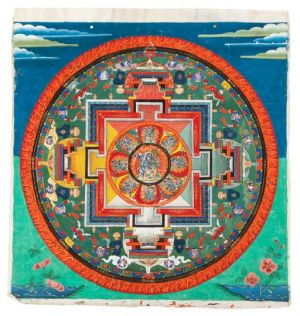Mahayana Uttaratantra Shastra- Vajra Point VI: Buddha Qualities
The 32 aspects detailing the qualities of a fully awakened buddha relate to directly to excellence in teaching and leading other sentient beings to perfect happiness; the main symbols associated with this chapter are
vajra is noted for its indestructibility and capacity to destroy all obstacles
lion is noted for his fearless presence, proclaiming the dharma deep in the jungles of samsaric views
space is unmixed with the dynamics of the other elements while allowing for their expression in the same way that the 18 qualities of body, speech and mind are unique to Buddhas while supporting worldly beings, sravakas, pratyekas, and bodhisattvas in their respective levels of present refinement. These last four are symbolized by earth, water, fire, and air. As for Buddhas, the text states, (p. 235) "Away from the features of the worldly and of those being beyond the world, they are similar to space."
moon in the water represents the two aspects of the Buddha's teaching; the moon itself represents the dharmakaya and the reflection symbolizes the form (rupa) kayas; the wisdom knowing correctly and the wisdom which knows completely.
The chapter also includes a detailed list of the 32 physical marks of the supreme nirmanakaya which is as close to unbelievable as it gets for me. This is not the form taken by all those who awaken but is an extremely rare emanation displayed in one like Shakyamuni Buddha who was of the special class known as supreme nirmanakaya.
Khenpo Tsultrim Gyamtso Rinpoche comments: A supreme nirmanakaya in all his beautiful signs and marks is only seen by a sentient being who has purified the veil of negative karma, whereas to someone whose mind is still obscured by former very negative actions he may appear in a very ordinary or even revulsive form, just as the clear reflection of the moon is only seen unpolluted water. [BN 385-6]
Khenchen Thrangu Rinpoche's commentary on The Uttara Tantra delineates the qualities of enlightenment in two ways, those with value for oneself which he relates to the absolute truth and the Dharmakaya, and value for others, which he relates to the relative truth and the Samboghakaya and Nirmanakaya. He explains that the qualities related to value for oneself relate to freedom and the qualities of value for others relate to maturity. Together they give fulfillment for oneself and others. I have listed what he says are the qualities with value for oneself. This is not a commentary; these are simply notes for study.
The first kaya which relates to value for oneself has 32 qualities of Freedom: ten powers, four fearlessnesses and eighteen distinctive qualities
the ten powers:
- 1. perfect knowledge of the appropriate and inappropriate
- 2. full understanding of karma
- 3. being able to gauge the intelligence of persons so that they may be taught according to their level
- 4. knowing the temperaments of beings so as to know which remedies to suggest
- 5. knowing the interests of beings so that they know which teachings will help them
- 6. knowing which path leads to less suffering, which to happiness in the here/now, and which leads to eternal happiness.
- 7. knowing the correct and incorrect way to meditate
- 8. remembering former lifetimes, attained through the practice of virtue
- 9. being able to see the future
- 10. knowing that all impurities have been perfectly eliminated
the four fearlessnesses:
- 1. fearless because they know they have nothing more to purify
- 2. fearless of contradiction because they know they have a correct understanding
- 3. fearless because they know that the path is the way to complete enlightenment
- 4. fearless because they have had no pride when teaching
and the 18 distinctive qualities:
- 1. it is not possible for their action to be a mistake
- 2. they do not speak meaninglessly or uselessly
- 3. their mindfulness never diminishes
- 4. they rest perpetually in meditation
- 5. they never think of deceiving others
- 6. they always act carefully, never casually
- 7. they never lose their aspiration to help other beings
- 8. they never lose their diligence
- 9. their memory never decreases
- 10. their understanding never becomes distorted
- 11. their perfect liberation does not change
- 12. they never lose their jñana
as related to qualities of activity:
- 13. their physical activities are preceded and followed by jñana
- 14. their speech is preceded and followed by jñana
- 15. their thoughts are preceded and followed by jñana as related to qualities of jñana
- 16. their jñana is unhindered by the past
- 17. their jñana is unhindered by the present
- 18. their jñana is unhindered by the future
These qualities are the result of freedom from obscurations, and manifest as knowledge of how-it-is and variety.
Source
